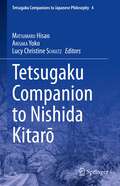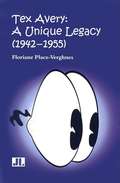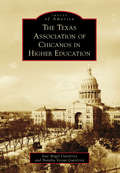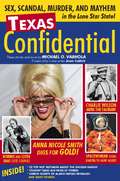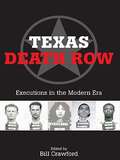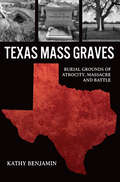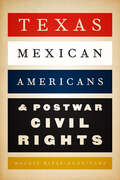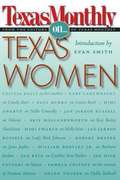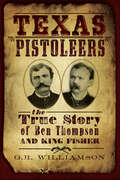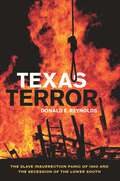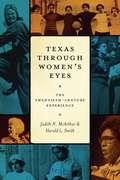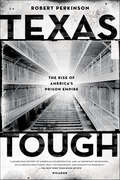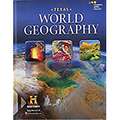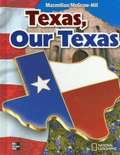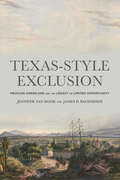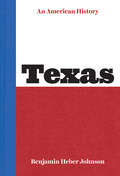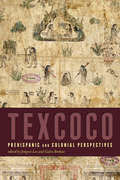- Table View
- List View
Tetsugaku Companion to Nishida Kitarō (Tetsugaku Companions to Japanese Philosophy #4)
by Hisao Matsumaru Yoko Arisaka Lucy Christine SchultzThis book offers the first comprehensive collection of essays on the key concepts of Kitaro Nishida (1870-1945), the father of modern Japanese philosophy and founder of the Kyoto School. The essays analyze several of the major philosophical concepts in Nishida, including pure experience, absolute will, place, and acting intuition. They examine the meaning and positioning of Nishida’s philosophy in the history of philosophy, as well as in the contemporary world, and discuss the relevance of his philosophy in the present context. The book next looks at the significance of Nishida’s philosophy in the wider contexts of science, arts, and religion. The book includes a glossary of key terms that have been translated in a unified manner throughout the volume.
Tex Avery: A Unique Legacy
by Floriane Place-VerghnesFloriane Place-Verghnes examines the work of this great American animator. Focusing primarily on four facets of Avery's work, the author first concentrates on Avery's ability to depict the American attempt both to retrieve the past nostalgically and to catch the Zeitgeist of 1940s America, which confronts the questions of violence and survival. She also analyzes issues of sex and gender and the crucial role Hollywood played in reshaping the image of womanhood, reducing it to a bipolar opposition. Thirdly, she examines the comic language developed by Avery which, although drawing on the work of the Marx Brothers and Chaplin (among others), transcended their conventions. Finally, Place-Verghnes considers Avery's place in the history of cartoon-making technique.
Texas Association of Chicanos in Higher Education, The
by Natalia Verjat Gutierrez Jose Angel GutierrezFor the past 40 years, the Texas Association of Chicanos in Higher Education (TACHE) has been on the forefront of advocacy to improve opportunity in higher education for US persons of Mexican origin. Chicano faculty at the University of Texas, together with a few Chicano students, organized the group's first gatherings in 1974, and since then, TACHE has held thematic annual conferences that signal its mission and program focus and allow professional networking. Chicano faculty and students in colleges and universities have increased, but much still remains to be done. Although funding for education is drastically being cut, Chicano and Latino students are at the front door of higher education, and the number of college-ready students is reaching significant levels across the nation. The official designation of Hispanic-Serving Institution (HSI), for schools with Chicano and Latino student enrollment in excess of 25 percent, has become a badge of honor among colleges and universities.
Texas Blood: Seven Generations Among the Outlaws, Ranchers, Indians, Missionaries, Soldiers, and Smugglers of the Borderlands
by Roger D. HodgeIn the tradition of Ian Frazier's Great Plains, and as vivid as the work of Cormac McCarthy, an intoxicating, singularly illuminating history of the Texas borderlands from their settlement through seven generations of Roger D. Hodge's ranching family. What brought the author's family to Texas? What is it about Texas that for centuries has exerted a powerful allure for adventurers and scoundrels, dreamers and desperate souls, outlaws and outliers? In search of answers, Hodge travels across his home state--which he loves and hates in shifting measure--tracing the wanderings of his ancestors into forgotten histories along vanished roads. Here is an unsentimental, keenly insightful attempt to grapple with all that makes Texas so magical, punishing, and polarizing. Here is a spellbindingly evocative portrait of the borderlands--with its brutal history of colonization, conquest, and genocide; where stories of death and drugs and desperation play out daily. And here is a contemplation of what it means that the ranching industry that has sustained families like Hodge's for almost two centuries is quickly fading away, taking with it a part of our larger, deep-rooted cultural inheritance. A wholly original fusion of memoir and history--as piercing as it is elegiac--Texas Blood is a triumph.
Texas Confidential
by Michael J. VarholaThe latest installment in the Confidential series, Texas Confidential pokes at the seamy underbelly of the Lone Star State, where folks do everything - including sex, scandal, murder, and mayhem - in a big way. Author Michael J. Varhola rounds up more than 40 Texas tales - from the rogues who defended the Alamo to the rogues who brought down Enron. Along the way, readers learn the sordid details of sex - from Miss Hattie's Bordello in West Texas (now a museum!) to "Charlie Wilson's Whore" scandal - from corrupt governors "Ma" and "Pa" Ferguson to corrupt politicians Lyndon Johnson and Tom DeLay; murder - from Bonnie and Clyde to the Kennedy Assassination to the over-zealous cheerleader mom; and mayhem - from the crash of a UFO in 1897 in the little town of Aurora to Nazi war criminals hiding in El Paso (while working for the local government). Packed with pictures and loaded with sidebars, Texas Confidential is informative, irreverent, and enormously entertaining.
Texas Death Row
by Bill CrawfordA chilling catalog of the men and women who have paid the ultimate price for their crimes The death penalty is one of the most hotly contested and longest-standing issues in American politics, and no place is more symbolic of that debate than Texas. Since the reinstatement of the death penalty in 1977, Texas has put more than 390 prisoners to death, far more than any other state. Texas Death Row puts faces to those condemned men and women, with stark details on their crimes, sentencing, last meals, and last words. Definitive and objective, Texas Death Row will provide ample fuel for readers on both sides of the death penalty debate.
Texas Graveyards: A Cultural Legacy (Elma Dill Russell Spencer Foundation Series)
by Terry G. JordanWhere more poignantly than in a small country graveyard can a traveler fathom the flow of history and tradition? During the past twenty years, Terry G. Jordan has traveled the back roads and hidden trails of rural Texas in search of such cemeteries. With camera in hand, he has visited more than one thousand cemeteries created and maintained by the Anglo-American, black, Indian, Mexican, and German settlers of Texas. His discoveries of sculptured stones and mounds, hex signs and epitaphs, intricate landscapes and unusual decorations represent a previously unstudied and unappreciated wealth of Texas folk art and tradition. Texas Graveyards not only marks the distinct ethnic and racial traditions in burial practices but also preserves a Texas legacy endangered by changing customs, rural depopulation, vandalism, and the erosion of time.
Texas Law For The Social Worker: A 2016 Sourcebook
by Vicki Hansen J. Ray HaysTEXAS LAW FOR THE SOCIAL WORKER: A 2016 SOURCEBOOK provides licensed social workers, social work students, and professors with the key legal and policy issues specific to the state of Texas today. Issues directly affecting practitioners and their students have been carefully selected from statutes, case laws, official archives of the Attorney General Opinions and Open Records Opinions, the Social Work Practice Act, and the NASW Code of Ethics. No other compilation of such critical, up-to-date material exists for the state of Texas. New up-to-date material from 83rd Legislative Session!
Texas Mass Graves: Burial Grounds of Atrocity, Massacre and Battle
by Kathy BenjaminEvery mass grave in Texas offers morbid proof that at one time, in that place, something went very, very wrong.Texans have resorted to mass graves out of necessity, desperation and appalling indifference. These sites mark natural disasters or hide unnatural crimes that tested the limits of human endurance and empathy. Because of this, memorializing those who lie in mass graves can be controversial. Not everyone wants to dig up the darkness of the past, much less admit that the dirt is still fresh. Nevertheless, to honor those whose bones lie mixed with others, their stories must be told. In so doing, Kathy Benjamin exhumes essential shards of Lone Star history, from the Alamo to the present day.
Texas Mexican Americans & Postwar Civil Rights
by Maggie Rivas-RodríuezAfter World War II, Mexican American veterans returned home to lead the civil rights struggles of the fifties, sixties, and seventies. Many of their stories have been recorded by the Voces Oral History Project (formerly the U.S. Latino & Latina World War II Oral History Project), founded and directed by Maggie Rivas-Rodriguez at the University of Texas at Austin School of Journalism. In this volume, she draws upon the vast resources of the Voces Project, as well as archives in other parts of the country, to tell the stories of three little-known advancements in Mexican American civil rights. The first two stories recount local civil rights efforts that typified the grassroots activism of Mexican Americans across the Southwest. One records the successful effort led by parents to integrate the Alpine, Texas, public schools in 1969—fifteen years after the U.S. Supreme Court ruled that separate schools were inherently unconstitutional. The second describes how El Paso’s first Mexican American mayor, Raymond Telles, quietly challenged institutionalized racism to integrate the city’s police and fire departments, thus opening civil service employment to Mexican Americans. The final account provides the first history of the early days of the Mexican American Legal Defense and Educational Fund (MALDEF) and its founder Pete Tijerina Jr. from MALDEF’s incorporation in San Antonio in 1968 until its move to San Francisco in 1972.
Texas Mexican Americans & Postwar Civil Rights
by Maggie Rivas-RodríuezThis volume recounts three Civil Rights victories that typify the work done by Mexican American veterans of WWII led the struggle across Texas. After World War II, Mexican American veterans returned home to lead the civil rights struggles of the fifties, sixties, and seventies. Many of their stories have been recorded by the Voces Oral History Project, founded and directed by Maggie Rivas-Rodriguez at the University of Texas at Austin School of Journalism. In this volume, Rivas-Rodriguez draws upon the vast resources of the Voces Project, as well as other archives, to tell the stories of three little-known advancements in Mexican American civil rights. The first story recounts the successful effort led by parents to integrate the Alpine, Texas, public schools in 1969, fifteen years after the US Supreme Court ruled that separate schools were inherently unconstitutional. The second describes how El Paso&’s first Mexican American mayor, Raymond Telles, quietly challenged institutionalized racism to integrate the city&’s police and fire departments, thus opening civil service employment to Mexican Americans. The final account details the early days of the Mexican American Legal Defense and Educational Fund (MALDEF) from its incorporation in San Antonio in 1968 until its move to San Francisco in 1972.
Texas Monthly On ... Texas Women
by Evan SmithSince 1973, Texas Monthly has spotlighted hundreds of Texans who, for better or worse, make this state like no place else. TEXAS MONTHLY On . . . Texas Women profiles thirteen women who are not only fascinating in their own right, but also representative of the legions of women who have contributed to the character and uniqueness of Texas. They range from First Ladies Laura Bush and Lady Bird Johnson to pop culture icons such as Candy Barr and Janis Joplin-and all of them exemplify the qualities that make Texas women distinctive. The women's profiles originally appeared as articles in the magazine, authored by some of Texas Monthly's notable writers-Cecilia Ballí, Gary Cartwright, Paul Burka, Mimi Swartz, Jan Jarboe Russell, Skip Hollandsworth, Robert Draper, William Broyles Jr. , Jan Reid, Joe Nick Patoski, Pamela Colloff, and Helen Thorpe. The writers also introduce their pieces with headnotes that update the stories or, in some cases, tell the story behind the story. TEXAS MONTHLY On . . . Texas Women is the first in a series of books in which the editors of Texas Monthly will offer the magazine's inimitable perspective on various aspects of Texas culture, including food, politics, travel, and music, among other topics.
Texas Pistoleers: The True Story of Ben Thompson and King Fisher (True Crime)
by G.R. WilliamsonThe Vaudeville Theater Ambush of 1884 went down in history as one of the most famous gunfights in San Antonio, but the killing that night of Ben Thompson and John King Fisher, two of the most notorious pistoleers of the day, became something of a mystery. The two men entered the theatre just before midnight on March 11, and less than an hour later, both lay dead, shot down in what for all accounts was a true massacre. The responsible gunmen never were prosecuted for their crimes, and Thompson and Fisher--a mere mention of either man's name was enough to put the fear of death in any opponent--have been widely ignored since. Now, historian G.R. Williamson brings to light the mystery and the myths surrounding these men and their infamous deaths in Texas Pistoleers.
Texas Studies Weekly: Welcome to Second Grade [Grade] 2 Social Studies
by Studies WeeklyNIMAC-sourced textbook
Texas Terror: The Slave Insurrection Panic of 1860 and the Secession of the Lower South (Conflicting Worlds: New Dimensions of the American Civil War)
by Donald E. ReynoldsOn July 8, 1860, fire destroyed the entire business section of Dallas, Texas. At about the same time, two other fires damaged towns near Dallas. Early reports indicated that spontaneous combustion was the cause of the blazes, but four days later, Charles Pryor, editor of the Dallas Herald, wrote letters to editors of pro-Democratic newspapers, alleging that the fires were the result of a vast abolitionist conspiracy, the purpose of which was to devastate northern Texas and free the region's slaves. White preachers from the North, he asserted, had recruited local slaves to set the fires, murder the white men of their region, and rape their wives and daughters. These sensational allegations set off an unprecedented panic that extended throughout the Lone Star State and beyond. In Texas Terror, Donald E. Reynolds offers a deft analysis of these events and illuminates the ways in which this fictionalized conspiracy determined the course of southern secession immediately before the Civil War. As Reynolds explains, all three fires probably resulted from a combination of extreme heat and the presence of new, and highly volatile, phosphorous matches in local stores. But from July until mid-September, vigilantes from the Red River to the Gulf of Mexico charged numerous whites and blacks with involvement in the alleged conspiracy and summarily hanged many of them. Southern newspapers reprinted lurid stories of the alleged abolitionist plot in Texas, and a spate of similar panics occurred in other states. States-rights Democrats asserted that the Republican Party had given tacit approval, if not active support, to the abolitionist scheme, and they repeatedly cited the "Texas Troubles" as an example of what would happen throughout the South if Lincoln were elected president. After Lincoln's election, secessionists charged that all who opposed immediate secession were inviting abolitionists to commit unspeakable depredations. Secessionists used this argument, as Reynolds clearly shows, with great effectiveness, particularly where there was significant opposition to immediate secession.Mining a rich vein of primary sources, Reynolds demonstrates that secessionists throughout the Lower South created public panic for a purpose: preparing a traditionally nationalistic region for withdrawal from the Union. Their exploitation of the "Texas Troubles," Reynolds asserts, was a critical and possibly decisive factor in the Lower South's decision to leave the Union of their fathers and form the Confederacy.
Texas Through Women's Eyes
by Judith N. Mcarthur Harold L. SmithTexas women broke barriers throughout the twentieth century, winning the right to vote, expanding their access to higher education, entering new professions, participating fully in civic and political life, and planning their families. Yet these major achievements have hardly been recognized in histories of twentieth-century Texas. By contrast, Texas Through Women’s Eyes offers a fascinating overview of women’s experiences and achievements in the twentieth century, with an inclusive focus on rural women, working-class women, and women of color. McArthur and Smith trace the history of Texas women through four eras. They discuss how women entered the public sphere to work for social reforms and the right to vote during the Progressive era (1900–1920); how they continued working for reform and social justice and for greater opportunities in education and the workforce during the Great Depression and World War II (1920–1945); how African American and Mexican American women fought for labor and civil rights while Anglo women laid the foundation for two-party politics during the postwar years (1945–1965); and how second-wave feminists (1965–2000) promoted diverse and sometimes competing goals, including passage of the Equal Rights Amendment, reproductive freedom, gender equity in sports, and the rise of the New Right and the Republican party.
Texas Tough: The Rise of America's Prison Empire
by Robert PerkinsonA vivid history of America's biggest, baddest prison system and how it came to lead the nation's punitive revolutionIn the prison business, all roads lead to Texas. The most locked-down state in the nation has led the way in criminal justice severity, from assembly-line executions to isolation supermaxes, from prison privatization to sentencing juveniles as adults. Texas Tough, a sweeping history of American imprisonment from the days of slavery to the present, shows how a plantation-based penal system once dismissed as barbaric became the national template. Drawing on convict accounts, official records, and interviews with prisoners, guards, and lawmakers, historian Robert Perkinson reveals the Southern roots of our present-day prison colossus. While conventional histories emphasize the North's rehabilitative approach, he shows how the retributive and profit-driven regime of the South ultimately triumphed. Most provocatively, he argues that just as convict leasing and segregation emerged in response to Reconstruction, so today's mass incarceration, with its vast racial disparities, must be seen as a backlash against civil rights. Illuminating for the first time the origins of America's prison juggernaut, Texas Tough points toward a more just and humane future.
Texas and Christmas: A Collection of Traditions, Memories and Folklore
by Judy Alter Joyce Gibson RoachThroughout the world, Christmas is special. And everywhere, from Maine to California and beyond the ocean, it is celebrated differently in each community, each home. Yet those who like to think Texas is special believe that Christmas in that state is bigger, better, and more treasured than anywhere else. This collection grew out of that conviction. Most of these pieces bring the past into the present, reviving traditions and memories of Christmases long gone. Others reflect the diversity of Texas people, and still others describe customs that are even today setting new traditions for the future. Want to make syllabub? The recipe is here. Curious about the way the Germans in South Central Texas once celebrated the holiday? Minetta Goyne captures those special customs. Elmer Kelton and Joyce Gibson Roach recall the joy and sadness of Christmases during World War II
Texas, Our Texas (Grade #4)
by James A. Banks Kevin P. Colleary Walter C. Parker Gloria Contreras Mary A. Mcfarland A. Lin Goodwin Richard O. BoehmThe Social Studies Strands are a way of thinking about social studies. Social studies is the study of people and the world we live in. This is a very big subject! One way to think about social studies is to break it into parts. We call these parts strands.
Texas-Style Exclusion: Mexican Americans and the Legacy of Limited Opportunity
by James D. Bachmeier Jennifer Van HookWhile Americans largely support legal immigration, this support is conditional on the basis that immigrants do not make use of public assistance. Previous generations of immigrants, such as European-origin Industrial Era immigrants, came to U.S. impoverished, worked hard, and achieved the American Dream seemingly on their own. Mexican immigrants, the nation’s largest contemporary immigrant group, are often viewed with suspicion and are accused of being dependent on the government and refusing to integrate into American society the “right way.” In Texas-Style Exclusion, sociologists Jennifer Van Hook and James D. Bachmeier investigate such claims by comparing how American society has responded to different groups of immigrants over time. Drawing on census and archival data on the quality of public schooling, Van Hook and Bachmeier find that Industrial Era European immigrants, who were primarily located in the northeastern U.S., benefited from programs and policies championed by the Americanization and Progressive movements. The Americanization movement sought to help acclimate new arrivals and transform “foreigners” into “Americans” by providing night school programs to promote civic integration and basic education, as well as other services. The Progressive movement, which aimed to improve education, work, and health conditions, sought to expand investment in public schools and make primary and secondary schooling mandatory, which kept working class children in school as opposed to entering the workforce. This access to education allowed for integration and astonishing intergenerational mobility. Mexican immigrants in the 1920s and 1930s, the majority of whom resided in Texas, had radically different experiences from their European counterparts. Mexicans in Texas were subjected to racism, segregation, labor exploitation, and intentional school failures. This resulted in tremendous generational disadvantage that persists to the current day. Mexicans from this cohort who left Texas for states with strong Americanization and Progressive movements saw improved educational outcomes and integration. Additionally, Mexicans who immigrated after the Civil Rights Movement saw significantly greater inter-generational mobility and educational attainment than earlier cohorts due to the protections provided by civil rights laws. Van Hook and Bachmeier conclude that whether one is optimistic or pessimistic about the integration of Mexican Americans depends on when and where one looks. Texas-Style Exclusion is an engaging examination of policies and practices that have been glossed over and forgotten that promoted mobility and integration for certain immigrant groups and impeded them for others.
Texas: An American History
by Benjamin Heber JohnsonAn exploration of the multifaceted characters and complex events that have defined the Lone Star State from its inception through today When Americans turn on their laptops, play video games, go to church, vote, eat TexMex, shop for groceries, listen to music, grill steaks, or watch football, they are, knowingly or not, paying tribute to Texas. Tracing the profound and surprising story of the Lone Star State, Benjamin Heber Johnson shines new light on why Texas has had such a powerful influence on U.S. history. Texas is known to outsiders for mob violence, swaggering self-conception, and conservative politics, but Johnson reveals that the state has also been on the forefront of taming frontier violence, establishing LGBTQ rights, and developing modern businesses such as organic food and personal computing. Neither looking away from the dark chapters of Texas history nor letting them overshadow the achievements of democracy and pluralism that are some of the state&’s greatest legacies, Johnson offers a balanced and inclusive history of an often contentious and stereotyped region, covering such topics as the persistence of Native Americans, the frontier story of the Alamo, agrarian populism, racial segregation, the state&’s porous border with Mexico, and the way historical memory continues to shape the state&’s identity. The reality of Texas, Johnson shows us, is even bigger than we think it is.
Texcoco
by Jongsoo Lee Galen BrokawTexcoco: Prehispanic and Colonial Perspectives presents an in-depth, highly nuanced historical understanding of this major indigenous Mesoamerican city from the conquest through the present. The book argues for the need to revise conclusions of past scholarship on familiar topics, deals with current debates that derive from differences in the way scholars view abundant and diverse iconographic and alphabetic sources, and proposes a new look at Texcocan history and culture from different academic disciplines. Contributors address some of the most pressing issues in Texcocan studies and bring new ones to light: the role of Texcoco in the Aztec empire, the construction and transformation of Prehispanic history in the colonial period, the continuity and transformation of indigenous culture and politics after the conquest, and the nature and importance of iconographic and alphabetic texts that originated in this city-state, such as the Codex Xolotl, the Mapa Quinatzin, and Fernando de Alva Ixtlilxochitl's chronicles. Multiple scholarly perspectives and methodological approaches offer alternative paradigms of research and open a needed dialogue among disciplines--social, political, literary, and art history, as well as the history of science. This comprehensive overview of Prehispanic and colonial Texcoco will be of interest to Mesoamerican scholars in the social sciences and humanities.
Texcoco: Prehispanic and Colonial Perspectives
by Jongsoo Lee and Galen BrokawTexcoco: Prehispanic and Colonial Perspectives presents an in-depth, highly nuanced historical understanding of this major indigenous Mesoamerican city from the conquest through the present. The book argues for the need to revise conclusions of past scholarship on familiar topics, deals with current debates that derive from differences in the way scholars view abundant and diverse iconographic and alphabetic sources, and proposes a new look at Texcocan history and culture from different academic disciplines. Contributors address some of the most pressing issues in Texcocan studies and bring new ones to light: the role of Texcoco in the Aztec empire, the construction and transformation of Prehispanic history in the colonial period, the continuity and transformation of indigenous culture and politics after the conquest, and the nature and importance of iconographic and alphabetic texts that originated in this city-state, such as the Codex Xolotl, the Mapa Quinatzin, and Fernando de Alva Ixtlilxochitl’s chronicles. Multiple scholarly perspectives and methodological approaches offer alternative paradigms of research and open a needed dialogue among disciplines—social, political, literary, and art history, as well as the history of science. This comprehensive overview of Prehispanic and colonial Texcoco will be of interest to Mesoamerican scholars in the social sciences and humanities.
Text + Field: Innovations in Rhetorical Method
by Robert Glenn Howard Robert Asen Sara L. McKinnon Karma R. ChávezRhetorical critics have long had a troubled relationship with method, viewing it as at times opening up provocative avenues of inquiry, and at other times as closing off paths toward meaningful engagement with texts. Text + Field shifts scholarly attention from this conflicted history, looking instead to the growing number of scholars who are supplementing text-based scholarship by venturing out into the field, where rhetoric is produced, enacted, and consumed. These field-based practices involve observation, ethnographic interviews, and performance. They are not intended to displace text-based approaches; rather, they expand the idea of method by helping rhetorical scholars arrive at new and complementary answers to long-standing disciplinary questions about text, context, audience, judgment, and ethics. The first volume in rhetoric and communication to directly address the relevance, processes, and implications of using field methods to augment traditional scholarship, Text + Field provides a framework for adapting these new tools to traditional rhetorical inquiry.Aside from the editors, the contributors are Roberta Chevrette, Kathleen M. de Onís, Danielle Endres, Joshua P. Ewalt, Alina Haliliuc, Aaron Hess, Jamie Landau, Michael Middleton, Tiara R. Na’puti, Jessy J. Ohl, Phaedra C. Pezzullo, Damien Smith Pfister, Samantha Senda-Cook, Lisa Silvestri, and Valerie Thatcher.
